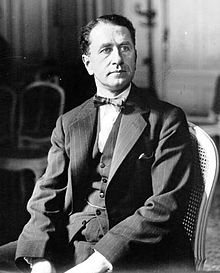Harry Grindell-Matthews
| Harry Grindell Matthews | |
|---|---|

Matthews in 1924
|
|
| Born |
March 17, 1880 Winterbourne, Gloucestershire, England |
| Died | September 11, 1941 (aged 61) England |
| Cause of death | heart attack |
| Education | Merchant Venturer's School |
| Occupation | Inventor |
| Spouse(s) |
Ganna Walska (m. 1938–1941; his death) |
Harry Grindell Matthews (17 March 1880 – 11 September 1941) was an English inventor who claimed to have invented a death ray in the 1920s.
Harry Grindell Matthews was born on 17 March 1880 in Winterbourne, Gloucestershire. He studied at the Merchant Venturers' School in Bristol and became an electronic engineer. During the Second Boer War he served in the South African Constabulary and was twice wounded.
In 1911 Matthews said he had invented an Aerophone device, a radiotelephone, and transmitted messages between a ground station and an aeroplane from a distance of two miles. His experiments attracted government attention and on 4 July 1912 he visited Buckingham Palace. However, when the British Admiralty requested a demonstration of the Aerophone, Matthews demanded that no experts be present at the scene. When four of the observers dismantled part of the apparatus before the demonstration began and took notes, Matthews cancelled the demonstration and drove observers away.
Newspapers rushed to Matthews's defence. The War Office denied any tampering and claimed that the demonstration was a failure. The government later stated that the affair was just a misunderstanding.
In 1914, after the outbreak of the First World War, the British government announced an award of £25,000 to anyone who could create a weapon against zeppelins or remotely control unmanned vehicles. Matthews claimed that he had created a remote control system that used selenium cells. He successfully demonstrated it with a remotely controlled boat to representatives of the Admiralty at Richmond Park's Penn Pond. He received his £25,000 but the admiralty never used the invention.
Next, Matthews appeared in public in 1921 and claimed to have invented the world's first talking picture, a farewell interview of Ernest Shackleton recorded on 16 September 1921, shortly before Shakleton's last expedition. The film was not commercially successful. Other talking-picture processes had been developed before that of Matthews, including processes by William K. L. Dickson, Photokinema (Orlando Kellum), and Phonofilm (Lee DeForest). However, Matthews claimed his process was the first sound-on-film process. Even if Matthews's process actually worked, it was certainly not the first.
...
Wikipedia
